
System Design
2 hours
System design is the blueprint for a software system. It's about defining the architecture, components, modules, interfaces, and data flow to achieve specific goals.
Please Notice
This project is inspired by concepts from "System Design Interview" by Alex Xu. The book provided invaluable insights into system design fundamentals.
Single Server Set Up
A single server setup is a configuration where all system components, such as the web server, database, application server, and file storage, reside on a single physical or virtual machine.
- The user accesses the website through a domain name.
- The
IP addressis returned to the browser - Hypertext transfer protocol requests are sent to the web server.
- The web server returns the HTML to the browser for rendering.
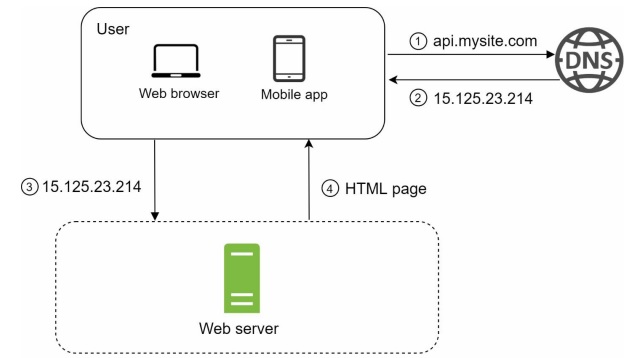
The script below illustrates an Apache web server deployment.
#!/bin/bash
----------------------------------------------------------------------------------
echo "Updating and installing apache2 and unzip..."
apt-get update
apt-get upgrade -y
apt-get install apache2 -y
apt-get install unzip -y
----------------------------------------------------------------------------------
echo "Getting the website from a remote repo..."
cd /tmp
wget https://github.com/denilsonbonatti/linux-site-dio/archive/refs/heads/main.zip
----------------------------------------------------------------------------------
echo "Unziping the file and pasting into the Apache directory..."
unzip main.zip
cd linux-site-dio-main
cp -R * /var/www/html/
----------------------------------------------------------------------------------
Database
With the growth of the user base, one server is not enough, and we need multiple servers: one for web/mobile traffic, and the other for the database. Separating web/mobile traffic (web tier) and database (data tier) servers allows them to be scaled independently.
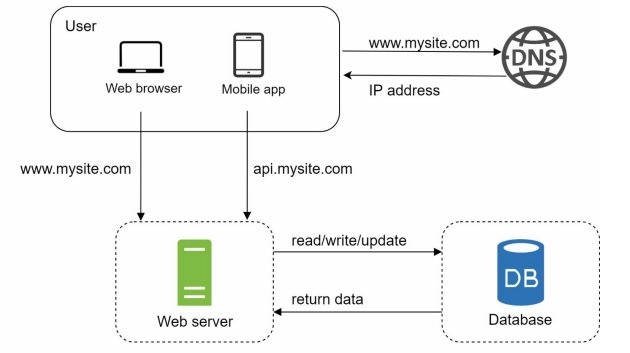
Here's a MySQL database containerized deployment using Kubernetes.
# Mysql deployment
apiVersion: apps/v1
kind: Deployment
metadata:
name: mysql
spec:
selector: # Select pods with the label "mysql"
matchLabels:
app: mysql
template: # a blueprint for creating pods
metadata: # Data about the data
labels: # Identify pods
app: mysql
spec:
containers:
- image: alemorales9011935/projeto-database:1.0 # Docker image used for the deployment
args:
- "--ignore-db-dir=lost+found" # Ignores previous deployments
imagePullPolicy: Always # Ensure the image is pulled even if exists locally
name: mysql
ports:
- containerPort: 3306
name: mysql
volumeMounts:
- name: mysql-dados
mountPath: /var/lib/mysql/ # where the containers will be storaged
volumes:
- name: mysql-dados
persistentVolumeClaim:
claimName: mysql-dados
Load Balancer
A load balancer evenly distributes incoming traffic among web servers that are defined in a load-balanced set. Users connect directly to the load balancer's public IP.
With this setup, web servers are no longer directly unreachable by clients.
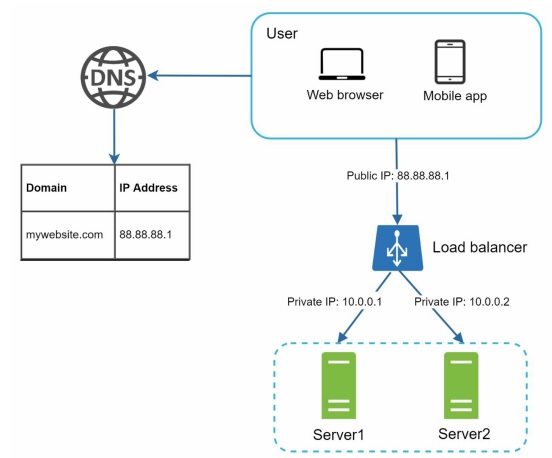
For better security, private IPs are used for communication between servers. A private IP is an IP address reachable only between servers in the same network; however, it is unreachable over the Internet.
The configuration below defines a LoadBalancer service for a PHP application using Kubernetes.
apiVersion: v1
kind: Service # Defines the type of Kubernetes object
metadata:
name: php
spec:
selector: # This service will find and route traffic to pods that have the label app: php.
app: php # Select pods with the label "app: php"
ports:
- port: 80 # The port users will access from outside the cluster
targetPort: 80 # The port php application listens
type: LoadBalancer # Type of Service
Database Replication
Database replication can be used in many database management systems, usually with a master/slave relationship between the original (master) and the copies (slaves). This architecture allows for failover and redundancy.
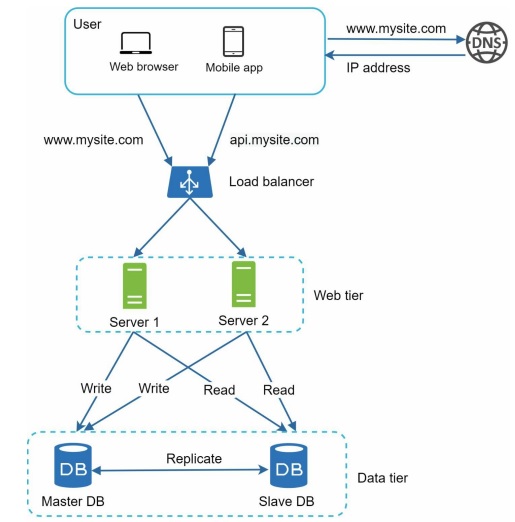
Here's a Data replication Deployment with docker-compose.
version: '3.7'
services:
mysql-master:
image: mysql:latest
container_name: mysql-master
environment:
MYSQL_ROOT_PASSWORD: your_root_password
MYSQL_DATABASE: your_database
MYSQL_USER: your_user
MYSQL_PASSWORD: your_password
MYSQL_REPLICATION_MODE: master
MYSQL_REPLICATION_USER: repl_user
MYSQL_REPLICATION_PASSWORD: repl_password
ports:
- "3306:3306"
volumes:
- mysql-data:/var/lib/mysql
mysql-slave:
image: mysql:latest
container_name: mysql-slave
environment:
MYSQL_ROOT_PASSWORD: your_root_password
MYSQL_DATABASE: your_database
MYSQL_USER: your_user
MYSQL_PASSWORD: your_password
MYSQL_REPLICATION_MODE: slave
MYSQL_REPLICATION_USER: repl_user
MYSQL_REPLICATION_PASSWORD: repl_password
MYSQL_MASTER_HOST: mysql-master
MYSQL_MASTER_PORT: 3306
ports:
- "3307:3306"
depends_on:
- mysql-master
volumes:
- mysql-data:/var/lib/mysql
volumes:
mysql-data:
Cache
A cache is a temporary storage area that stores the result of expensive responses or frequently accessed data in memory so that subsequent requests are served more quickly.
Common Use Cases
- Caching: Improve application performance by storing frequently accessed data in memory.
- Session management: Store user session data for faster access.
- Messaging: Real-time communication between applications.

Caching with Redis: Redis stands for Remote DIctionary Server. It's an open-source, in-memory data structure store that's primarily used as a cache or quick-response database. Here's a simple Redis deployment using docker-compose.
version: '3.7'
services:
redis:
image: redis:latest
container_name: redis
ports:
- "6379:6379"
CDN (Content Delivery Network)
A CDN is a network of geographically dispersed servers used to deliver static content. CDN servers cache static content like images, videos, CSS, and JavaScript files.

- User A tries to get image.png by using an image URL. The CDN provider provides the URL’s domain.
- If the CDN server does not have image.png in the cache, the CDN server requests the file from the origin, which can be a web server or online storage like Amazon S3.
- The origin returns image.png to the CDN server, which includes an optional HTTP header Time-to-Live (TTL) which describes how long the image is cached.
- The CDN caches the image and returns it to User A. The image remains cached in the CDN until the TTL expires.
- User B sends a request to get the same image.
- The image is returned from the cache as long as the TTL has not expired.
Here's a basic implementation of a CDN using Nginx:
http {
proxy_cache_path /var/cache/nginx/proxy_cache levels=1 keys_zone=my_cache:10m max_size=10g inactive=60m use_temp_path=off;
server {
listen 80;
server_name cdn.example.com;
location /images/ {
proxy_pass http://origin_server;
proxy_cache my_cache;
proxy_cache_valid 200 1h;
proxy_cache_use_stale error timeout invalid_header;
}
}
}
proxy_cache_path:Defines the cache directory, size, and other parameters.server block:Configures the CDN server listening on port 80.location blocks:Define specific paths for different content types.proxy_pass:Specifies the origin server where the content resides.proxy_cache:Enables caching for the specified location.proxy_cache_valid:Sets the cache expiration time for successful responses.proxy_cache_use_stale:Defines behavior when the cache is stale.
Stateless vs Statesfull
A stateful server remembers client data (state) from one request to the next. A stateless server keeps no state information.
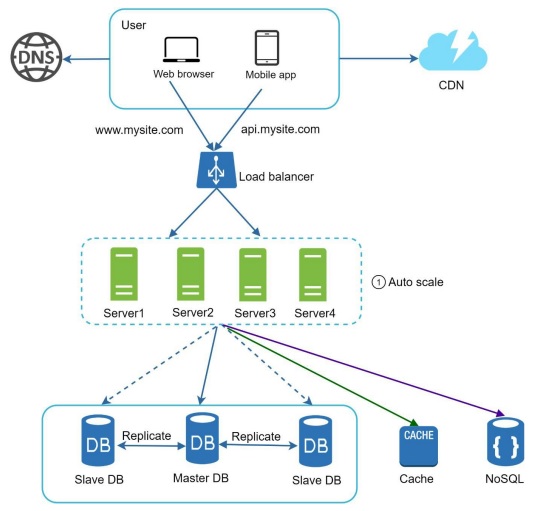
We move the session data out of the web tier and store them in the persistent data store. The shared data store could be a relational database, Memcached/Redis, NoSQL, etc. The NoSQL data store was chosen because it is easy to scale.
Autoscaling means adding or removing web servers automatically based on the traffic load. After the state data is removed from web servers, auto-scaling of the web tier is easily achieved by adding or removing servers based on traffic load.
Data Centers
To improve availability and provide a better user experience across wider geographical areas, supporting multiple data centers is crucial. In normal operation, users are geoDNS-routed, also known as geo-routed, to the closest data center, with split traffic of x% in US-East and (100 – x)% in US-West. geoDNS is a DNS service that allows domain
names to be resolved to IP addresses based on the location of a user.
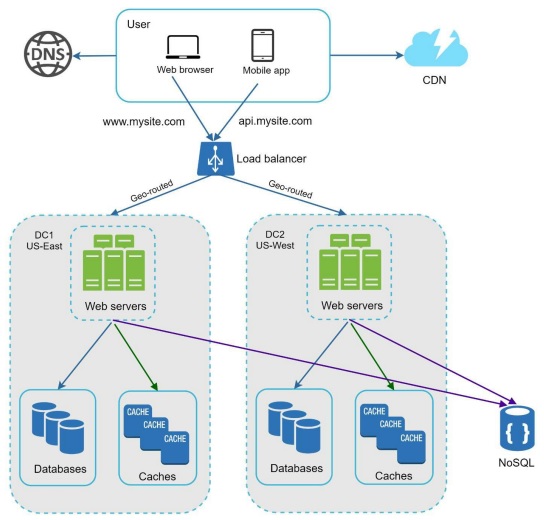
Message Queue
A message queue is a durable component, stored in memory, that supports asynchronous communication. It serves as a buffer and distributes asynchronous requests.

Input services, called producers/publishers, create messages and publish them to a message queue. Other services or servers, called consumers/subscribers, connect to the queue and perform actions defined by the messages.
Common Use Cases:
Order Processing:Handling order placement, inventory updates, shipping notifications, etc.Data Processing:Batching and processing large datasets.Microservices Architecture:Enabling communication between services.Event-Driven Architectures:Processing events and triggering actions.
Monitoring
Logging:Monitoring error logs is important because it helps to identify errors and problems in the system.Metrics:Collecting different types of metrics helps us to gain business insights and understand the health status of the system.Automation:When a system gets big and complex, we need to build or leverage automation tools to improve productivity.
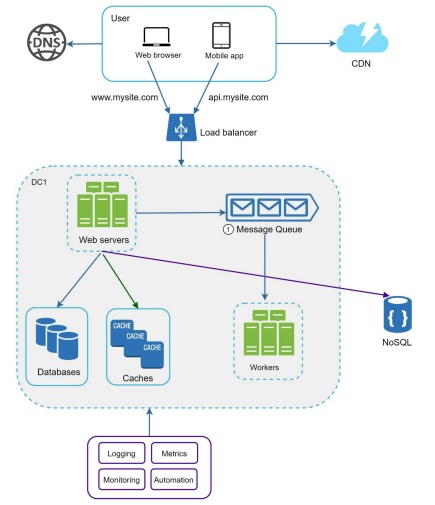
Vertical vs Horizontal Scaling
Vertical scaling: Switching for a more capable server(scaling up). Simple-"expensive"
Horizontal Scaling: Adding more servers(sharding). Complex-"cheaper"
Conclussion
System design is the blueprint for a software system, outlining its components, architecture, and how they interact. It's the foundation upon which software development and DevOps processes are built.